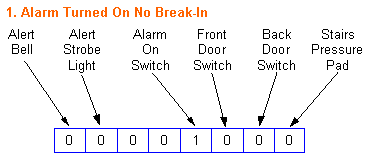| | Control : Bit Patterns |
|
When data is collected from sensors it is converted into digital data by an interface. This digital data is transmitted to a computer as a binary number.
Simple devices such as bells or bulbs can be activated by an interface sending an electrical voltage to them. The computer tells the interface whether to activate a device or not by sending it a bit. A 0 tells the interface to turn the device off and a 1 tells the interface to turn the device on.
Many control systems only use digital sensors and simple devices. In these systems all of the data that is passed between the computer and the interface can be represented as a group of bits in a byte, with each bit indicating the status of a sensor or controlling the status of a device.
This diagram shows data that is being used by a control system for a burglar alarm :

The current status of the alarm can be determined by interpreting the pattern of bits in the byte of data. Each bit represents the status of one sensor or device. Note that :
The alarm is currently switched on. This can be seen because the bit that relates to the Alarm On Switch is set to 1. The alarm has not detected a break-in. If a break-in is detected one of the sensors used to identify this (the door switches or pressure pad on the stairs) will set its bit to 1.
This diagram shows the change that occurs when a break-in happens :

The intruder has opened the front door. This has triggered the Front Door Switch so the bit associated with this sensor has been set to a 1. The computer responds by activating the Alert Bell and Alert Strobe Light devices. It does this by setting the corresponding bits to 1 :

This type of system, with the values of bits in a byte representing the status of sensors and devices is used by many control systems.
GCSE ICT Companion 04 - (C) P Meakin 2004